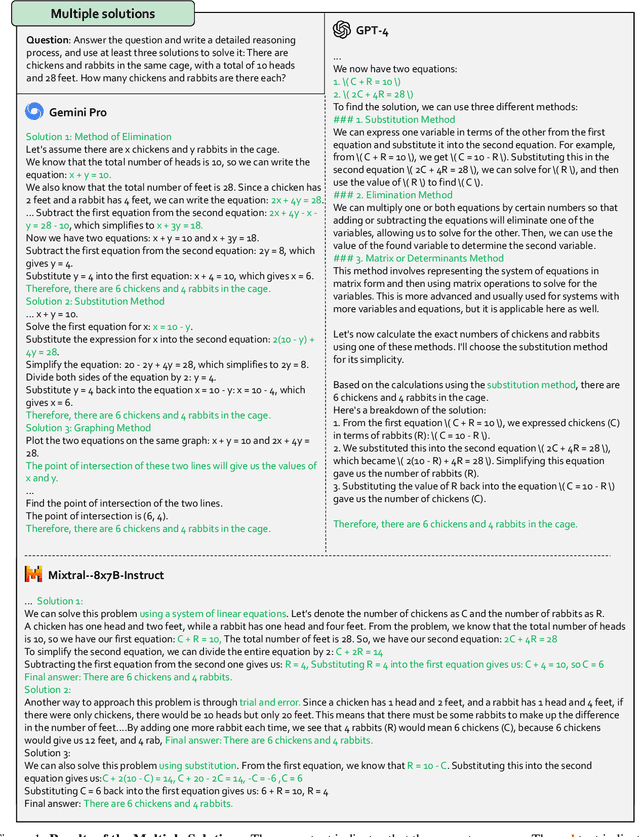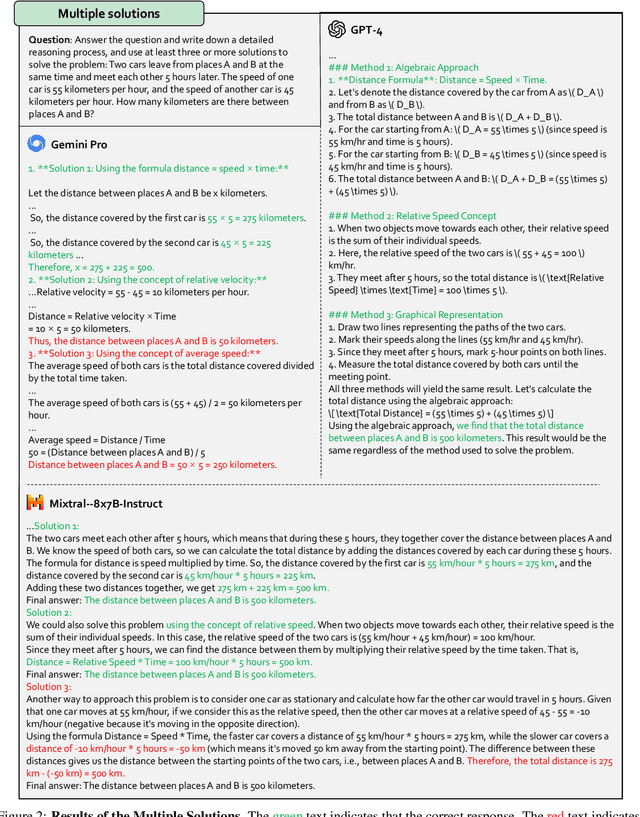Lijun Li
Stop Summation: Min-Form Credit Assignment Is All Process Reward Model Needs for Reasoning
Apr 21, 2025Abstract:Process reward models (PRMs) have proven effective for test-time scaling of Large Language Models (LLMs) on challenging reasoning tasks. However, reward hacking issues with PRMs limit their successful application in reinforcement fine-tuning. In this paper, we identify the main cause of PRM-induced reward hacking: the canonical summation-form credit assignment in reinforcement learning (RL), which defines the value as cumulative gamma-decayed future rewards, easily induces LLMs to hack steps with high rewards. To address this, we propose PURE: Process sUpervised Reinforcement lEarning. The key innovation of PURE is a min-form credit assignment that formulates the value function as the minimum of future rewards. This method significantly alleviates reward hacking by limiting the value function range and distributing advantages more reasonably. Through extensive experiments on 3 base models, we show that PRM-based approaches enabling min-form credit assignment achieve comparable reasoning performance to verifiable reward-based methods within only 30% steps. In contrast, the canonical sum-form credit assignment collapses training even at the beginning! Additionally, when we supplement PRM-based fine-tuning with just 10% verifiable rewards, we further alleviate reward hacking and produce the best fine-tuned model based on Qwen2.5-Math-7B in our experiments, achieving 82.5% accuracy on AMC23 and 53.3% average accuracy across 5 benchmarks. Moreover, we summarize the observed reward hacking cases and analyze the causes of training collapse. Code and models are available at https://github.com/CJReinforce/PURE.
Iterative Value Function Optimization for Guided Decoding
Mar 05, 2025Abstract:While Reinforcement Learning from Human Feedback (RLHF) has become the predominant method for controlling language model outputs, it suffers from high computational costs and training instability. Guided decoding, especially value-guided methods, offers a cost-effective alternative by controlling outputs without re-training models. However, the accuracy of the value function is crucial for value-guided decoding, as inaccuracies can lead to suboptimal decision-making and degraded performance. Existing methods struggle with accurately estimating the optimal value function, leading to less effective control. We propose Iterative Value Function Optimization, a novel framework that addresses these limitations through two key components: Monte Carlo Value Estimation, which reduces estimation variance by exploring diverse trajectories, and Iterative On-Policy Optimization, which progressively improves value estimation through collecting trajectories from value-guided policies. Extensive experiments on text summarization, multi-turn dialogue, and instruction following demonstrate the effectiveness of value-guided decoding approaches in aligning language models. These approaches not only achieve alignment but also significantly reduce computational costs by leveraging principled value function optimization for efficient and effective control.
Rethinking Bottlenecks in Safety Fine-Tuning of Vision Language Models
Jan 30, 2025Abstract:Large Vision-Language Models (VLMs) have achieved remarkable performance across a wide range of tasks. However, their deployment in safety-critical domains poses significant challenges. Existing safety fine-tuning methods, which focus on textual or multimodal content, fall short in addressing challenging cases or disrupt the balance between helpfulness and harmlessness. Our evaluation highlights a safety reasoning gap: these methods lack safety visual reasoning ability, leading to such bottlenecks. To address this limitation and enhance both visual perception and reasoning in safety-critical contexts, we propose a novel dataset that integrates multi-image inputs with safety Chain-of-Thought (CoT) labels as fine-grained reasoning logic to improve model performance. Specifically, we introduce the Multi-Image Safety (MIS) dataset, an instruction-following dataset tailored for multi-image safety scenarios, consisting of training and test splits. Our experiments demonstrate that fine-tuning InternVL2.5-8B with MIS significantly outperforms both powerful open-source models and API-based models in challenging multi-image tasks requiring safety-related visual reasoning. This approach not only delivers exceptional safety performance but also preserves general capabilities without any trade-offs. Specifically, fine-tuning with MIS increases average accuracy by 0.83% across five general benchmarks and reduces the Attack Success Rate (ASR) on multiple safety benchmarks by a large margin. Data and Models are released under: \href{https://dripnowhy.github.io/MIS/}{\texttt{https://dripnowhy.github.io/MIS/}}
WorldSimBench: Towards Video Generation Models as World Simulators
Oct 23, 2024



Abstract:Recent advancements in predictive models have demonstrated exceptional capabilities in predicting the future state of objects and scenes. However, the lack of categorization based on inherent characteristics continues to hinder the progress of predictive model development. Additionally, existing benchmarks are unable to effectively evaluate higher-capability, highly embodied predictive models from an embodied perspective. In this work, we classify the functionalities of predictive models into a hierarchy and take the first step in evaluating World Simulators by proposing a dual evaluation framework called WorldSimBench. WorldSimBench includes Explicit Perceptual Evaluation and Implicit Manipulative Evaluation, encompassing human preference assessments from the visual perspective and action-level evaluations in embodied tasks, covering three representative embodied scenarios: Open-Ended Embodied Environment, Autonomous, Driving, and Robot Manipulation. In the Explicit Perceptual Evaluation, we introduce the HF-Embodied Dataset, a video assessment dataset based on fine-grained human feedback, which we use to train a Human Preference Evaluator that aligns with human perception and explicitly assesses the visual fidelity of World Simulators. In the Implicit Manipulative Evaluation, we assess the video-action consistency of World Simulators by evaluating whether the generated situation-aware video can be accurately translated into the correct control signals in dynamic environments. Our comprehensive evaluation offers key insights that can drive further innovation in video generation models, positioning World Simulators as a pivotal advancement toward embodied artificial intelligence.
A Spatiotemporal Hand-Eye Calibration for Trajectory Alignment in Visual(-Inertial) Odometry Evaluation
Apr 23, 2024



Abstract:A common prerequisite for evaluating a visual(-inertial) odometry (VO/VIO) algorithm is to align the timestamps and the reference frame of its estimated trajectory with a reference ground-truth derived from a system of superior precision, such as a motion capture system. The trajectory-based alignment, typically modeled as a classic hand-eye calibration, significantly influences the accuracy of evaluation metrics. However, traditional calibration methods are susceptible to the quality of the input poses. Few studies have taken this into account when evaluating VO/VIO trajectories that usually suffer from noise and drift. To fill this gap, we propose a novel spatiotemporal hand-eye calibration algorithm that fully leverages multiple constraints from screw theory for enhanced accuracy and robustness. Experimental results show that our algorithm has better performance and is less noise-prone than state-of-the-art methods.
* 8 pages, 9 figures, 2 tables
Assessment of Multimodal Large Language Models in Alignment with Human Values
Mar 26, 2024Abstract:Large Language Models (LLMs) aim to serve as versatile assistants aligned with human values, as defined by the principles of being helpful, honest, and harmless (hhh). However, in terms of Multimodal Large Language Models (MLLMs), despite their commendable performance in perception and reasoning tasks, their alignment with human values remains largely unexplored, given the complexity of defining hhh dimensions in the visual world and the difficulty in collecting relevant data that accurately mirrors real-world situations. To address this gap, we introduce Ch3Ef, a Compreh3ensive Evaluation dataset and strategy for assessing alignment with human expectations. Ch3Ef dataset contains 1002 human-annotated data samples, covering 12 domains and 46 tasks based on the hhh principle. We also present a unified evaluation strategy supporting assessment across various scenarios and different perspectives. Based on the evaluation results, we summarize over 10 key findings that deepen the understanding of MLLM capabilities, limitations, and the dynamic relationships between evaluation levels, guiding future advancements in the field.
EasyJailbreak: A Unified Framework for Jailbreaking Large Language Models
Mar 18, 2024Abstract:Jailbreak attacks are crucial for identifying and mitigating the security vulnerabilities of Large Language Models (LLMs). They are designed to bypass safeguards and elicit prohibited outputs. However, due to significant differences among various jailbreak methods, there is no standard implementation framework available for the community, which limits comprehensive security evaluations. This paper introduces EasyJailbreak, a unified framework simplifying the construction and evaluation of jailbreak attacks against LLMs. It builds jailbreak attacks using four components: Selector, Mutator, Constraint, and Evaluator. This modular framework enables researchers to easily construct attacks from combinations of novel and existing components. So far, EasyJailbreak supports 11 distinct jailbreak methods and facilitates the security validation of a broad spectrum of LLMs. Our validation across 10 distinct LLMs reveals a significant vulnerability, with an average breach probability of 60% under various jailbreaking attacks. Notably, even advanced models like GPT-3.5-Turbo and GPT-4 exhibit average Attack Success Rates (ASR) of 57% and 33%, respectively. We have released a wealth of resources for researchers, including a web platform, PyPI published package, screencast video, and experimental outputs.
SALAD-Bench: A Hierarchical and Comprehensive Safety Benchmark for Large Language Models
Feb 08, 2024Abstract:In the rapidly evolving landscape of Large Language Models (LLMs), ensuring robust safety measures is paramount. To meet this crucial need, we propose \emph{SALAD-Bench}, a safety benchmark specifically designed for evaluating LLMs, attack, and defense methods. Distinguished by its breadth, SALAD-Bench transcends conventional benchmarks through its large scale, rich diversity, intricate taxonomy spanning three levels, and versatile functionalities.SALAD-Bench is crafted with a meticulous array of questions, from standard queries to complex ones enriched with attack, defense modifications and multiple-choice. To effectively manage the inherent complexity, we introduce an innovative evaluators: the LLM-based MD-Judge for QA pairs with a particular focus on attack-enhanced queries, ensuring a seamless, and reliable evaluation. Above components extend SALAD-Bench from standard LLM safety evaluation to both LLM attack and defense methods evaluation, ensuring the joint-purpose utility. Our extensive experiments shed light on the resilience of LLMs against emerging threats and the efficacy of contemporary defense tactics. Data and evaluator are released under https://github.com/OpenSafetyLab/SALAD-BENCH.
From GPT-4 to Gemini and Beyond: Assessing the Landscape of MLLMs on Generalizability, Trustworthiness and Causality through Four Modalities
Jan 29, 2024



Abstract:Multi-modal Large Language Models (MLLMs) have shown impressive abilities in generating reasonable responses with respect to multi-modal contents. However, there is still a wide gap between the performance of recent MLLM-based applications and the expectation of the broad public, even though the most powerful OpenAI's GPT-4 and Google's Gemini have been deployed. This paper strives to enhance understanding of the gap through the lens of a qualitative study on the generalizability, trustworthiness, and causal reasoning capabilities of recent proprietary and open-source MLLMs across four modalities: ie, text, code, image, and video, ultimately aiming to improve the transparency of MLLMs. We believe these properties are several representative factors that define the reliability of MLLMs, in supporting various downstream applications. To be specific, we evaluate the closed-source GPT-4 and Gemini and 6 open-source LLMs and MLLMs. Overall we evaluate 230 manually designed cases, where the qualitative results are then summarized into 12 scores (ie, 4 modalities times 3 properties). In total, we uncover 14 empirical findings that are useful to understand the capabilities and limitations of both proprietary and open-source MLLMs, towards more reliable downstream multi-modal applications.
PsySafe: A Comprehensive Framework for Psychological-based Attack, Defense, and Evaluation of Multi-agent System Safety
Jan 22, 2024Abstract:Multi-agent systems, augmented with Large Language Models (LLMs), demonstrate significant capabilities for collective intelligence. However, the potential misuse of this intelligence for malicious purposes presents significant risks. To date, comprehensive research on the safety issues associated with multi-agent systems remains limited. From the perspective of agent psychology, we discover that the dark psychological states of agents can lead to severe safety issues. To address these issues, we propose a comprehensive framework grounded in agent psychology. In our framework, we focus on three aspects: identifying how dark personality traits in agents might lead to risky behaviors, designing defense strategies to mitigate these risks, and evaluating the safety of multi-agent systems from both psychological and behavioral perspectives. Our experiments reveal several intriguing phenomena, such as the collective dangerous behaviors among agents, agents' propensity for self-reflection when engaging in dangerous behavior, and the correlation between agents' psychological assessments and their dangerous behaviors. We anticipate that our framework and observations will provide valuable insights for further research into the safety of multi-agent systems. We will make our data and code publicly accessible at https:/github.com/AI4Good24/PsySafe.
 Add to Chrome
Add to Chrome Add to Firefox
Add to Firefox Add to Edge
Add to Edge